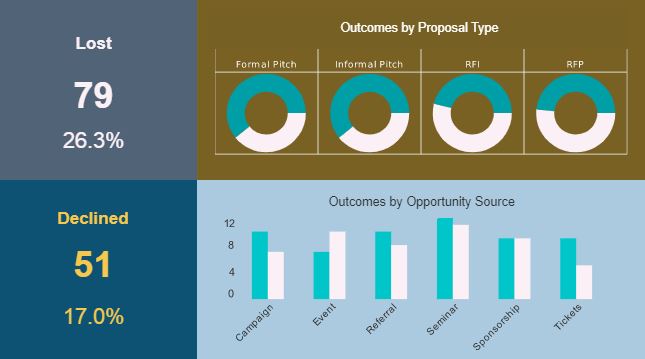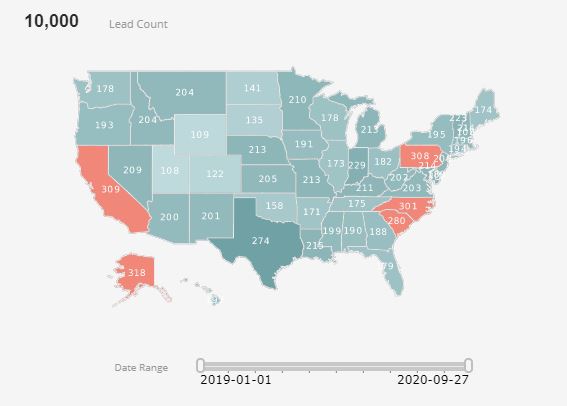InetSoft's Simple Management Dashboards
Below are some good examples of simple management dashboards. A simple management dashboard can be looked at as an executive tool whose sole purpose it to make information easier to read. These dashboards can include a variety of different types of data, which can all be integrated into an easy to read dashboard. Simple management dashboards allow users to seamlessly transition from one graph to another, without losing any important data.
In order to gain the competitive edge in a particular market, your business needs to be able to read, track, and convert the data that is constantly changing everyday. These interactive dashboards control every aspect of your business. Whether you need to keep track of daily expenses, monthly inventory reports, or quarterly earning, a good management dashboard can help do that.
To distinguish itself from others, a simple management dashboard will give you the ability to track three key components of your business.
InetSoft's Software for Simple Management Dashboards
A simple management dashboard is a business management tool that will allow a business to keep track of all aspects of their daily activity. On this page there are examples of simple management dashboards built with InetSoft's easy-to-use dashboard software. For example, this marketing lead management dashboard is able to track sales leads on the east coast and compare them with your sales on the west coast.
When lead conversion unexpectedly rises or falls, you are able to investigate the reasons behind this and make the necessary changes to keep your business profitable. By converting your businesses numerical data into graphical/visual representations, simple management dashboards allow the users to gain better insight to the more intricate parts of their business that they previously did not understand.
Why a Faux Fur Manufacturer Would Move from Geckoboard to InetSoft’s Serverless Dashboard App
For a niche manufacturer like a faux fur producer, dashboards are more than pretty gauges on a TV — they’re the nerve center that connects production line throughput, material inventory, quality inspections, order fulfillment, and sales channels. When that manufacturer outgrows the lightweight approach of Geckoboard, moving to a serverless, enterprise-capable platform such as InetSoft’s StyleBI (serverless dashboard microservice) can be a pragmatic decision that reduces total cost of ownership, lowers operational overhead, and raises both IT and end-user satisfaction.
Immediate differences in licensing and pricing model
- Geckoboard’s seat-and-dashboard pricing: Geckoboard’s packaging is oriented to smaller teams and TV-focused operational dashboards, with entry plans in the low double-digits to low hundreds per month depending on dashboards, editors and viewers. This makes it attractive for quick pilots but expensive to scale broadly across dozens of floor supervisors and remote managers.
- InetSoft’s hybrid licensing and pay-for-usage cloud options: InetSoft offers multiple procurement models — small multisite packs, perpetual licenses with maintenance, and session-hour / vCore-hour cloud consumption plans that let organizations pay for compute only when dashboards are used. This provides a clear path from a small site license to enterprise-wide deployments without the per-dashboard pricing shock of scaling on a competitor focused on seat-count.
- How pricing translates to a faux fur factory: For a manufacturer with 30–100 daily users (mix of editors, operational viewers and executive consumers), the InetSoft model typically reduces per-user annual spend once you adopt session-hour or tenant pricing, avoids large upfront per-TV or per-dashboard fees, and removes the need to buy incremental editor seats for every new report type.
Resource and infrastructure overhead — why serverless matters
Geckoboard is a cloud-first, SaaS product that is deliberately simple: you sign up, connect sources and publish a dashboard. The tradeoff for that simplicity is limited control over caching, transformation, and enterprise data connections. InetSoft’s serverless StyleBI flips the arithmetic: the vendor manages the microservice infrastructure and you consume session/vCore hours rather than provisioning and maintaining VM fleets. The practical benefits for the factory’s IT team are tangible:
- No dashboard server to provision or patch: The serverless microservice runs in the cloud and/or as embedded microservices, reducing patching windows, OS/stack upgrades and capacity planning work that traditionally sits with IT. That eliminates routine labor and reduces risk of security misconfiguration.
- Elastic compute for peak load: Production spikes (e.g., seasonal order surges before winter or a sudden materials shortage) can drive many concurrent dashboard viewers. Serverless architectures scale elastically so the factory doesn’t pay for idle capacity between peaks.
- Data mashup and caching reduce backend load: InetSoft’s caching and data mashup engine can transform and aggregate multiple sources (ERP, MES, spreadsheets, cloud order feeds) before rendering — lowering query load on core systems and reducing the need for synchronous ETL windows that are costly in a mixed legacy environment.
Operational and support savings
When the faux fur manufacturer evaluates total operations cost, several line-items move in favor of a serverless InetSoft deployment:
- Lower day-to-day sysadmin labor: With no VM to manage and fewer scheduled maintenance windows, the IT team can reallocate 10–30% of their dashboard-related time to higher-value tasks like data quality or integration projects. This is often the first “hidden” saving organizations notice.
- Reduced incident triage: Vendor-managed microservices and built-in monitoring minimize time spent chasing availability issues caused by OS patches, Java/Kubernetes problems, or capacity misconfigurations. InetSoft’s focus on lightweight microservices reduces the mean time to repair compared to managing a custom dashboard server farm.
- Predictable support and maintenance costs: InetSoft offers traditional maintenance for perpetual licenses (commonly quoted as a percent of license value) as well as cloud subscription/consumption pricing. That predictable model simplifies budgeting versus per-seat/capacity escalations that can happen with vendors whose tiers are tightly tied to dashboard count or TV endpoints.
Developer and integration productivity gains
Faux fur manufacturing environments are data heterogeneous: legacy AS/400 ERP exports, Excel import sheets from multiple suppliers, an MES that streams production counts, and e-commerce order APIs. InetSoft’s data mashup capabilities are engineered to combine those sources in real-time or near-real-time in the dashboard layer, without demanding a lengthy ETL project. For developers and integrators that means:
- Faster time-to-first-dashboard because data can be joined and transformed within the BI layer rather than requiring separate data engineering projects.
- Reduced custom connector work: InetSoft supports a wide variety of connectors and can be extended where needed, minimizing bespoke integration code that would otherwise be an ongoing support liability.
- Reusable data mashups and cached datasets that let multiple dashboards share calculations, improving maintainability and avoiding “report sprawl.”
Management and end-user satisfaction — concrete outcomes
From the plant manager who needs a live view of defects per shift to the CFO checking weekly sales by SKU, dashboards must be fast, reliable and actionable. Switching from a lightweight SaaS that’s optimized for simple TV KPIs to an enterprise-capable serverless platform yields measurable satisfaction improvements:
- Fewer “I can’t see my data” tickets: The richer connector set and caching mean users rarely hit refresh errors or timeouts when hitting consolidated dashboards — which reduces frustration for operations staff and speeds decision cycles.
- Faster iteration on new KPIs: Business users can request new calculated metrics that are provisioned by power-users in hours or days rather than weeks, improving perceived agility and increasing adoption. InetSoft’s web-based designer supports both power users and IT-controlled governance, which is a sweet spot for manufacturers who need both speed and control.
- Executive confidence and broader rollout: When dashboards are performant and governance is straightforward, senior management is more willing to roll dashboards out to multiple plants, carriers, and supplier partners — spreading benefits and lowering per-site cost.
Risks and trade-offs to consider
No migration is without trade-offs. Key things the faux fur maker should evaluate:
- Feature parity for simple TV-style KPIs: If Geckoboard’s TV-friendly widgets and ultra-fast setup are the only priority, the team should ensure that InetSoft’s dashboard templates meet the same operational visibility needs without longer authoring times. However, the long-term flexibility usually offsets the initial setup effort.
- Change management: Moving to a richer platform requires a short investment in user training and a governance model so power users don’t create inconsistent KPI definitions across groups.
- Cost modeling: The organization must do a proper cost comparison using realistic usage patterns (session hours, expected concurrency, number of persistent dashboards) rather than raw seat counts to see the serverless economics in full. InetSoft’s consumption pricing options make that modeling straightforward.


